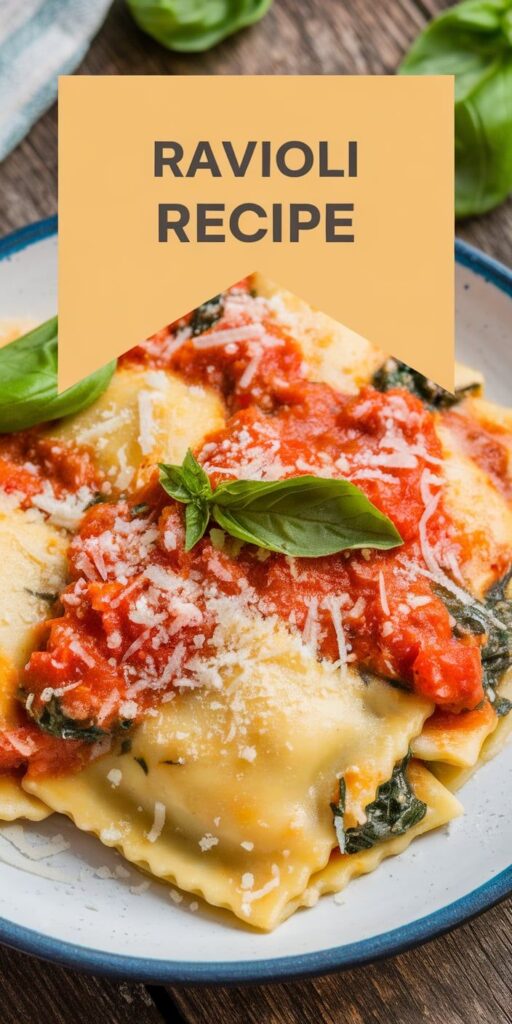Welcome to the ultimate homemade ravioli adventure! As a passionate home chef, I’ve discovered that crafting this delicious pasta recipe is more than just cooking—it’s an art form rooted in Italian cuisine. Making ravioli from scratch transforms an ordinary meal into an extraordinary culinary experience.
In this comprehensive guide, I’ll walk you through every step of creating perfect ravioli. Whether you’re a kitchen novice or an experienced cook, my detailed instructions will help you master this classic Italian dish. By the end of this recipe, you’ll understand why homemade ravioli is so much more satisfying than store-bought versions.
Get ready to impress your family and friends with authentic, handcrafted pasta that captures the essence of traditional Italian cooking. Your ravioli-making journey starts right here!

Why Making Homemade Ravioli Will Transform Your Pasta Game
Diving into the world of traditional ravioli is more than just a cooking adventure—it’s a culinary journey that connects you with centuries of Italian cooking techniques. As someone passionate about authentic cuisine, I’ve discovered that making homemade pasta is an art form that elevates your kitchen skills and dining experience.
The Rich History of Italian Ravioli
Ravioli originated in the Middle Ages, becoming a beloved staple in Italian households. These delicate pasta pockets emerged as a creative way to use leftover ingredients, transforming simple foods into extraordinary meals. The tradition of crafting ravioli by hand has been passed down through generations, preserving a culinary heritage that celebrates creativity and resourcefulness.
Benefits of Making Ravioli From Scratch
- Complete control over ingredient quality
- Fresh, superior taste compared to store-bought options
- Unlimited filling customization
- Healthier alternative with no preservatives
- Enjoyable cooking experience
What Makes This Recipe Special
My approach to traditional ravioli focuses on authenticity and simplicity. By using classic Italian cooking techniques, you’ll create pasta that tells a story—each bite represents generations of culinary expertise. The homemade pasta benefits extend beyond taste, offering a deeply satisfying connection to food preparation that store-bought options simply cannot match.
Whether you’re a seasoned cook or a kitchen novice, mastering homemade ravioli will transform your understanding of pasta-making, turning an everyday meal into a memorable culinary experience.
Essential Ingredients for the Perfect Ravioli Recipe
Creating delicious homemade ravioli starts with selecting the right ravioli ingredients. I’ll guide you through the essential components that will transform your fresh pasta dough into a culinary masterpiece.
For the pasta dough, you’ll need a few simple but high-quality ingredients. King Arthur All-Purpose Flour provides the perfect base for fresh pasta dough. Pair it with fresh eggs from local farms to create a rich, silky texture that elevates your ravioli fillings.
- Flour: King Arthur All-Purpose Flour
- Eggs: Fresh, large farm eggs
- Salt: Kosher or sea salt
- Olive oil: Extra virgin, cold-pressed
When considering ravioli fillings, the possibilities are endless. I recommend starting with classic ingredients that complement your pasta dough:
| Filling Type | Key Ingredients | Flavor Profile |
|---|---|---|
| Classic Cheese | Ricotta, Parmesan, Mozzarella | Creamy, Mild |
| Meat Filling | Ground beef, Pork, Italian herbs | Rich, Savory |
| Vegetarian | Spinach, Ricotta, Nutmeg | Earthy, Delicate |
Quality matters when selecting your ingredients. I always recommend using fresh, locally sourced products whenever possible. The right ingredients will elevate your homemade ravioli from good to extraordinary.
Kitchen Tools and Equipment You’ll Need
Creating delicious homemade ravioli requires the right pasta making tools and equipment. Whether you’re a beginner or an experienced home cook, having the proper tools can make your ravioli-making experience smooth and enjoyable.
Must-Have Pasta Making Tools
To start your ravioli adventure, you’ll need some essential tools that will help you craft perfect pasta every time. Here are the key items:
- Large mixing bowl for preparing dough
- Rolling pin or pasta machine for creating thin, even pasta sheets
- Sharp knife or ravioli cutter for precise pasta shaping
- Measuring cups and spoons
- Clean work surface for rolling and cutting
Optional Equipment for Easier Preparation
While not absolutely necessary, these additional tools can simplify your ravioli-making process:
- Pasta machine for consistent dough thickness
- Ravioli mold or stamp for uniform shapes
- Pastry wheel for decorative edges
- Kitchen scale for precise ingredient measurements
Setting Up Your Workspace
An organized workspace is crucial when working with pasta dough. I recommend clearing a large, clean counter space and gathering all your pasta making tools before you begin. A wooden surface works best for rolling out dough, as it provides the right amount of grip and prevents sticking.
| Tool Category | Essential Items | Recommended Brands |
|---|---|---|
| Dough Preparation | Mixing bowl, measuring cups | KitchenAid, Pyrex |
| Pasta Shaping | Ravioli cutter, pasta machine | Marcato Atlas, Imperia |
| Workspace | Large wooden surface, flour | Maple cutting board |
Making the Perfect Ravioli Dough
Crafting the ideal ravioli dough is an art that transforms your homemade pasta from good to extraordinary. My ravioli dough recipe combines simple ingredients with precise pasta dough techniques to create a silky, tender pasta that will impress even the most discerning Italian food lovers.
Let’s dive into the essential ingredients for an authentic ravioli dough recipe:
- 2 cups all-purpose flour
- 3 large eggs
- 1 tablespoon olive oil
- 1/2 teaspoon salt
When preparing your homemade pasta tips, remember that technique matters as much as ingredients. Start by creating a flour well on a clean work surface. Crack the eggs into the center, adding olive oil and salt. Gradually incorporate the flour into the eggs using a fork, then knead the dough by hand.
My favorite pasta dough techniques involve working the dough until it becomes smooth and elastic. This typically takes about 10 minutes of consistent kneading. The key is to develop the gluten, which gives pasta its signature texture.
| Texture | What It Means | Action Needed |
|---|---|---|
| Too Dry | Crumbly, won’t hold together | Add water, 1 teaspoon at a time |
| Too Sticky | Wet and difficult to handle | Dust with flour, knead gently |
| Perfect | Smooth, elastic, slightly tacky | Rest for 30 minutes before rolling |
Pro tip: Always let your ravioli dough rest, wrapped in plastic, for at least 30 minutes. This allows the gluten to relax, making the dough easier to roll and preventing tough pasta.
Creating Delicious Ravioli Fillings
Crafting the perfect ravioli filling is an art that transforms simple pasta into a culinary masterpiece. The right filling can elevate your cheese ravioli, meat ravioli, or vegetarian ravioli from ordinary to extraordinary. I’ll guide you through creating mouth-watering ravioli filling recipes that will impress your family and friends.
Classic Cheese Filling
For a traditional cheese ravioli, I recommend a rich blend of cheeses that creates a creamy and flavorful center. Here’s my go-to recipe:
- 15 oz ricotta cheese
- 1 cup grated Parmesan
- 1 large egg
- Fresh chopped parsley
- Salt and pepper to taste
Mix ingredients thoroughly, ensuring a smooth consistency. The key is to blend the cheeses until they’re well incorporated but not overmixed.
Meat Filling Options
Meat ravioli offers a hearty and satisfying option for pasta lovers. I prefer a classic ground beef filling with robust seasonings:
- 1 lb ground beef
- 1/2 cup breadcrumbs
- 1 egg
- Minced garlic
- Dried oregano
- Grated Parmesan cheese
Brown the meat thoroughly, drain excess fat, and mix with other ingredients for a flavorful filling that holds together perfectly.
Vegetarian Alternatives
Vegetarian ravioli can be just as delicious and satisfying. My favorite filling combines roasted vegetables and creamy cheese:
- Roasted butternut squash
- Spinach
- Goat cheese
- Toasted pine nuts
- Fresh thyme
Roast vegetables first, then chop and mix with cheese for a filling that’s packed with flavor and nutrition. These ravioli filling recipes offer something for every taste preference.
Cooking and Serving Your Fresh Ravioli
Cooking fresh ravioli is an art that transforms your homemade pasta into a delectable meal. I recommend boiling your handcrafted ravioli in salted water for 3-4 minutes until they float to the surface. The key is watching for that perfect al dente texture – soft yet slightly firm to the bite.
When it comes to ravioli sauce recipes, simplicity reigns supreme. A classic sage brown butter sauce brings out the rich flavors of your pasta. Melt butter in a pan, add fresh sage leaves, and let them crisp slightly. The nutty aroma will elevate your dish from home cooking to gourmet experience.
Serving suggestions can make your ravioli truly shine. I love garnishing with fresh parmesan, chopped herbs like basil or parsley, and a light drizzle of extra virgin olive oil. Pair your ravioli with a crisp white wine like Pinot Grigio to complement the delicate pasta texture and filling.
Plating matters as much as taste. Arrange your ravioli in a shallow white dish, allowing the sauce to pool elegantly around the pasta. A sprinkle of freshly cracked black pepper adds a final touch of sophistication to your homemade masterpiece.



